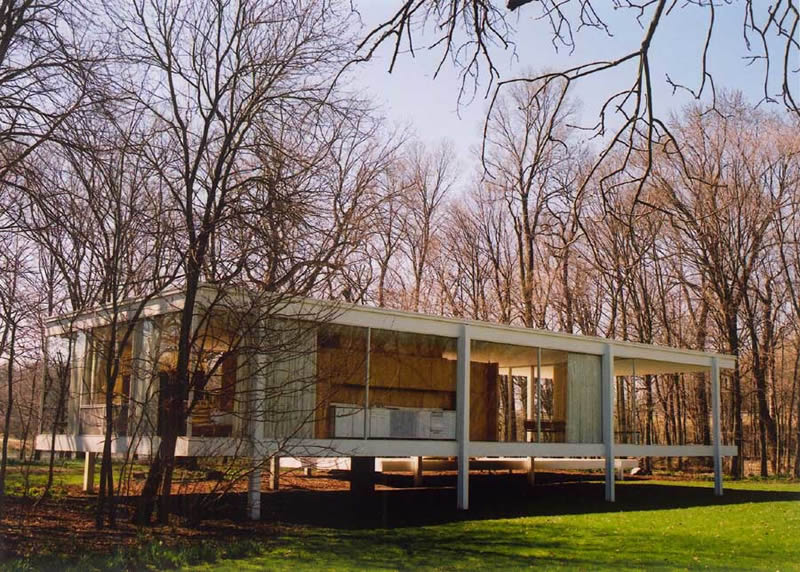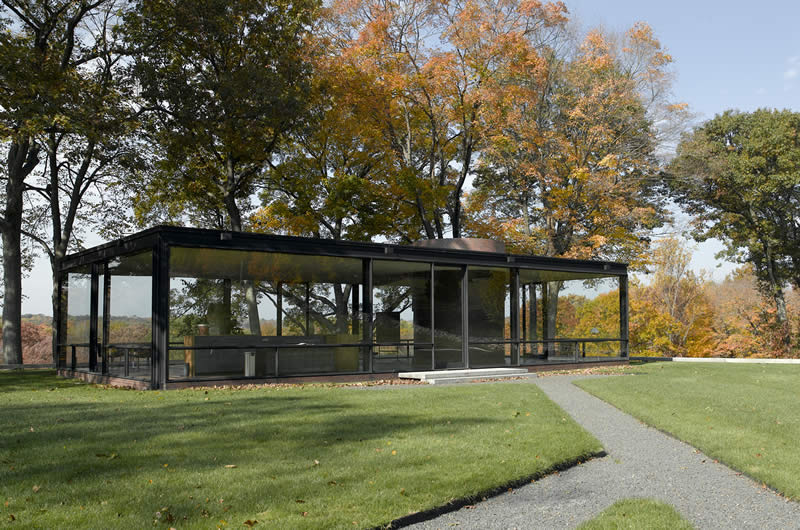"I’m a plagiarist man — you see, you must take everything from everybody"
Philip Johnson, interview with Susan Sontag.
With all the press jouissance over the possibility of a clone of a Zaha Hadid project in China being completed before the original, there is a historical precedent of the copy preceding the original, in perhaps the greatest act of architectural plagiarism to date. The story concerns two of the most famous buildings of the Modern Movement, The Farnsworth House by Mies van der Rohe, and Philip Johnson's Glass House.
The original in this scenario in Mies' Farnsworth House, planned in 1945 For Mrs Farnsworth in Plano, Illinois, but completed in 1951. A model was exhibited at the MOMA in 1947, at a show about modern architecture part curated by, you guessed it, Philip Johnson. Johnson was able to design and build The Glass House for himself quicker than Mies, with his project completed in 1949 and subsequently widely published in the architectural press.

Mies was understandably said to be furious, partly because he thought people would conclude that his was the derivative work. And it's not difficult to see the direct influence of one upon the other, both being essentially glass boxes, with full height glazing, and a flat roof supported by edge mounted columns giving an entirely free plan, with a central service core. There are differences of course, primarily the raised platform upon which the Farnsworth House sits, and the white paintwork. In contrast, the Glass House sits into the ground more, and with its darker colouring, sits more within the landscape than against it. In Johnson's Glass House, the corner columns together with the floor and roof slabs creates a box-like frame, whereas Mies, in moving the columns inwards, dissolves the edges and make the horizontal elements float more.

David Holowka, in a wonderful article on his Architakes blog, calls Johnson's iterations "history's worst case of the anxiety of influence", and later recalls Franz Schulze, "biographer of both men, states in Philip Johnson, Life and Work, that Mies belabored Johnson 'not for having copied him but for trying to and failing.'"
Johnson went through many variations in his design for the Glass House, somewhere between 27 (the official view) and 79 (according to his assistant Landis Gores). As the Architakes article describes: "After 25 tries, Johnson’s tortured resignation that the Farnsworth House was not to be improved upon is on full view in penultimate scheme 26′s nearly actionable plagiarism of its plan.",
Mies and Johnson continued to have an uneasy professional relationship, working together on the Seagram building in New York. Mies visited Johnson at the Glass House in 1955, but famously refused to stay there. "After a night of drinking, Mies picked at the Glass House's details until Johnson indirectly retaliated by challenging the greatness of one of Mies's favorite buildings, Berlage's Amsterdam Stock Exchange. In a 1985 interview by Robert A.M. Stern published in The Philip Johnson Tapes, Johnson describes Mies’s quietly angry response: "I’m not staying here tonight. Find me another place to stay."
Here is a short Sarah Morris' 2010 film 'Points on a Line':
Sarah Morris "Points on a Line" from Sarah Morris on Vimeo.
Who owns an architectural idiom? After all, Mies didn't invent modernist architecture or the idea of building a house from steel and glass, even if we can admit that the Farnsworth House represents a high-water mark for Modernism. We can sense that Johnson's Glass house has crossed a boundary between inspiration and plagiarism, without being able to explain fully why. It is a fuzzy boundary, and any artistic endeavour will alway find it hard to separate inspiration from duplication. As far as I know, the rules of copyright do not apply to architecture in the same way that they do not apply to fashion. Buildings and clothes are both regarded as utility, and therefore unable to be registered.
It is only Western architecture of the 20th century that began to prize uniqueness in architectural designs so highly, and denigrate similarity and duplication in favour of a radical individuality. Johnson's building, while certainly derivative, ultimately arrives at a different destination from the Mies house. While the Farnsworth House sits against the landscape, the Glass House rests within it, and both solutions are equally valid. Unlike the Chinese clone of a Hadid design, it is not simply a context-free rip-off.
